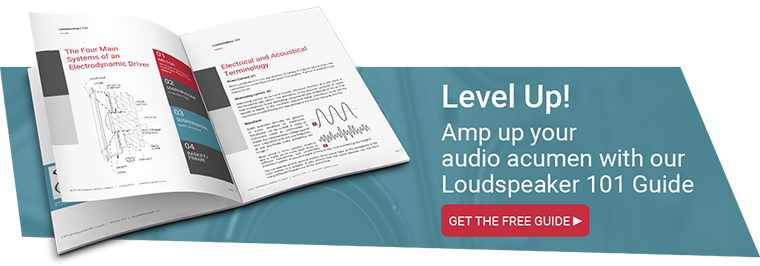How the Q Factor of a Speaker Impacts Audio Projects
Speakers make noise by vibrating the speaker cone back and forth. Vibrations like this create resonance. Resonance is what happens when sound waves travel through an object and get amplified at certain frequencies. With speakers, one of those objects is the enclosure (which will have its own resonant frequency), and that will impact the overall sound quality of a system.
One way a manufacturer measures how a speaker’s inner workings are operating so it can get the resonance of the full system just right is the total Q factor (or Qts) of the speaker. This unitless decimal tells you how the various parts of the speaker, like the suspension, spider, voice coil, magnet, and cone, are moving when the speaker is at its resonant frequency.
Resource: Audio Acronyms for Speaker Design
The Q factor takes into account the electrical and mechanical properties of the speaker (because the driver is turning alternating current electricity into mechanical energy via the voice coil and magnet). The Q factor of any resonant system describes how lossy it is. It’s helpful to know Q is the inverse of damping (d = 1/Q).
To get speakers that sound good in their final locations, it’s important you communicate with the manufacturer and discuss resonance early on in the design process. A good manufacturer will have existing prototypes that fit your desired parameters, or they should be able to offer material and design suggestions to help you get there. This conversation may include examining the mechanical Q (Qms), electrical Q (Qes), and Qts of the speaker.
Resource: Speaker Specs 101
The Qms represent the damping mainly in the speaker’s suspension. Because Q is the inverse of damping, a lower value means higher damping. The Qes represents the damping of the fundamental resonance by the braking action of the motor. Again, a lower value means higher damping. The Qts represents the damping of all causes and is the parallel combination of Qms and Qes. This is the value of Q that is most important for system designers to know.
Getting the Right Enclosure
The Qts informs decisions about speaker enclosures. As a rule of thumb, a Qts below 0.4 means a speaker should be put in a ported enclosure. A Qts above 0.5 means the speaker is better suited for a sealed box. You can take the analysis a step further and look at the efficiency bandwidth product (EBP) of a speaker.
The EBP is the free-air resonant frequency (Fs) divided by the Qes, and it shows the trade-off between the efficiency of a speaker and the bandwidth of frequencies a driver performs well over. It is useful in determining if a driver is suited for a ported (vented) enclosure or horn loading.
As a general rule:
- EBP < 50 = the best enclosure is a sealed box
- EBP = 50-100 = use either a sealed or a ported box
- EBP > 100 = use a ported box only
Efficiency and bandwidth are inversely related. For the best efficiency, the bandwidth must be narrow. For the largest bandwidth, the efficiency must become less. However, a ported enclosure can help increase the efficiency of a speaker. This is one of the design “tricks” transducer engineers can suggest to help meet the parameters of your project. MISCO has even created proprietary dual-ported speakers to help customers get louder sound out of smaller spaces.
